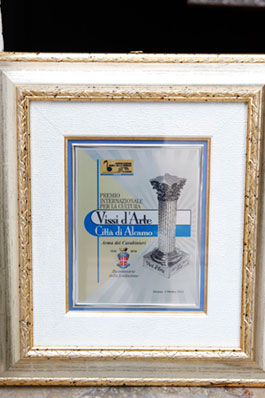
2014
|
Arma dei Carabinieri The corps of Royal Carabinieri was instituted under the Royal Patents of July 13, 1814, by King Victor Emmanuel I of Savoywith the aim of providing the Kingdom with a police corps able “to ensure good order and public tranquillity”. These military police officers were supposed not only to be loyal and reliable, but to also understand the needs of the local territories they were guarding and act with promptness and humanity. The Corps, similarly to the French National Gendarmerie, had both civilian (public order and criminal investigation) and military (defence of the nation and military police) tasks. Carabinieri’s first glorious enterprise took place in Grenoble, France, during the final campaign against Napoleon. On July 6, 1815 a Carabineri cavalry squadron charged the French troops, forcing them to escape, thus significantly contributing to the coalition’s victory . In 1861, when Italy was being almost entirely unified (with the exception of Veneto and the Holy Seat), the military and civilian police structures were joined together under the new State. The Legion of Palermo was established on March 6, 1861. During the years prior to World War I, Carabinieri still had several military and civilian tasks, both in Italy and abroad. In 1908, the Corps stood out providing aid to the victims of the earthquake that hit the straits of Messina, to the extent that the Corps was awarded the Gold Medal of Merit. In 1915, when the Great War began, Carabinieri were dispatched to all frontlines. When joined in the 3rd Battalion, they bravely fought on Mount Podgora, dying in a battle that later became the symbol of their value and loyalty. On June 5, 1920, the first Gold Medal of Military Value was awarded to the Corps to honour the 5,000 officers who had died in combat. Later on, the second Gold Medal of Military Value was awarded in remembrance of the sacrifice of Carabinieri’s First Division deployed in eastern Africa for strenuously defending the Culqualber Pass from August 6 to November 21, 1941, against the overwhelming British army during World War II. After September 8, 1943, Carabinieri remained in their position , trying to protect the people whose lives they were to defend. The most significant event was the immolation of Vice Brigadier Salvo D’Acquisto, who sacrificed himself to save the lives of 24 hostages, which represents the clearest example of a Carabiniere firmly, devotedly and nobly accomplishing his duty till death. Many members of Carabinieri contributed to the Italian Resistance Movement, even supporting and joining groups of partisans and sometimes even leading them. Once the war was over, the Royal Army was incorporated into the Italian army, and the Corps of Royal Carabinieri was named “Arma dei Carabinieri”, the first Corps of the new army. On December 8, 1949, Pope Pius XII proclaimed the Holy Mary as the patron saint of the Corps, with the title of “Virgo Fidelis”, establishing a recurring celebration on November 21, i.e. the anniversary of the battle of Culqualber. Starting from the late 1960s, a ferocious challenge was brought against Italy’s democratic institutions by political subversive groups. In order to properly oppose such subversion, a special anti-terrorism unit was created on May 22, 1974, which was headed by General Carlo Alberto Dalla Chiesa – who later became the Police Forces and Secret Agents National Coordinator on August 9, 1978. The work of his team was instrumental to disrupt the terrorist networks. Carabinieri have been frequently called to participate in operational missions abroad, a tradition dating back to 1855, always distinguishing themselves for their capacity to accomplish military and police tasks. Particularly significant is their constant involvement and commitment in UNO and NATO missions. Nowadays, the Corps still “ensures good order and public tranquillity”, through an extraordinary and privileged relationship with the Italian citizens, also thanks to the Corps’s daily contact with the people through 4,600 local stations disseminated throughout the whole Italian territory. This is an old mission, assigned to Carabinieri in 1814 by the then Kingdom of Piedmont and Sardinia, which has remained unchanged until today. Reasons for awarding the prize Established on July 13, 1814, the Corps of Carabinieri has been a constant reference point for society along a two century’s history of wars and peace. These military police officers have always showed great professionalism and unforgettable courage in their constant protection of the civilian population, back from the time of the Italian unification to today’s successful achievements against organized crime. The Corps of Carabinieri represents the leading edge in the protection of the environment, artistic heritage, citizens’ health, as well as for the surveillance over the labour safety regulations. Carabinieri are a flagship also abroad, due to their involvement in several international peacekeeping activities. Now that the Corps is entering into its third century of life, the high professionalism of its members and the wise use of state-of-the-art technologies perfectly combine with the historically-renowned qualities of its officers, such as loyalty, devotion, humanity and the dedicated vicinity to the needs of the people.
Da sinistra Paola Zanoni presentatrice, il Colonnello Fernando Nazzaro Comandante Provinciale dei Carabinieri, il Dott. Francesco Bambina Presidente dell'Associazione "Amici della Musica" di Alcamo e il Dott. Sebastiano Bonventre sindaco del Comune di Alcamo      |

Per informazioni: Associazione “Amici della Musica”
Via F.lli S. Anna, 77 - 91011 Alcamo (TP) -Tel. +39 0924 505744 - Fax +39 0924 1916611 - Cell. +39 335 7073611
VoIP Skype: amicidellamusicaalcamo
info@amicimusicaalcamo.it
Partita Iva 01374350815

